Everything you need to know about hiking in Patagonia, from Torres del Paine to El Chalten: when to visit, best hikes, how to plan and what to pack.
Are you ready to embark on the adventure of a lifetime? Patagonia beckons hikers from around the globe. Situated in the southern regions of Chile and Argentina, this remote corner of our planet boasts awe-inspiring landscapes, challenging trails and unique wildlife. From the iconic Torres del Paine to the hidden gems of Ushuaia, Patagonia has something for everyone.
Whether embarking on a scenic trail or multi-day hike, you can expect a treasure trove of windswept landscapes, jagged granite spires, immense glaciers, and some of the largest ice fields on Earth. In this ultimate guide to hiking in Patagonia, we’ll equip you with all the information you need to plan your dream trek.
This article contains affiliate links from the Amazon Associate and Travelpayouts programs. Wild Travel Tales will earn from qualifying purchases, at no extra cost to you.
The Best Time to Go Hiking in Patagonia
Before we dive into the specific treks, let’s talk about the best time to visit Patagonia. Each season offers a unique experience, and your choice will depend on your budget, tolerance for different weather conditions and other travel plans. In this section, we’ll delve into the weather patterns, seasons, and the ideal months for hiking in Patagonia.
Generally, the period from early November to late April is considered ideal for hiking. If you prefer milder temperatures, aim for February and March. For the full spectrum of Patagonian beauty, visit in late March to mid-April when the region is painted in stunning autumn colours. However, Patagonia’s weather is known for its unpredictability, so be prepared for sudden changes.
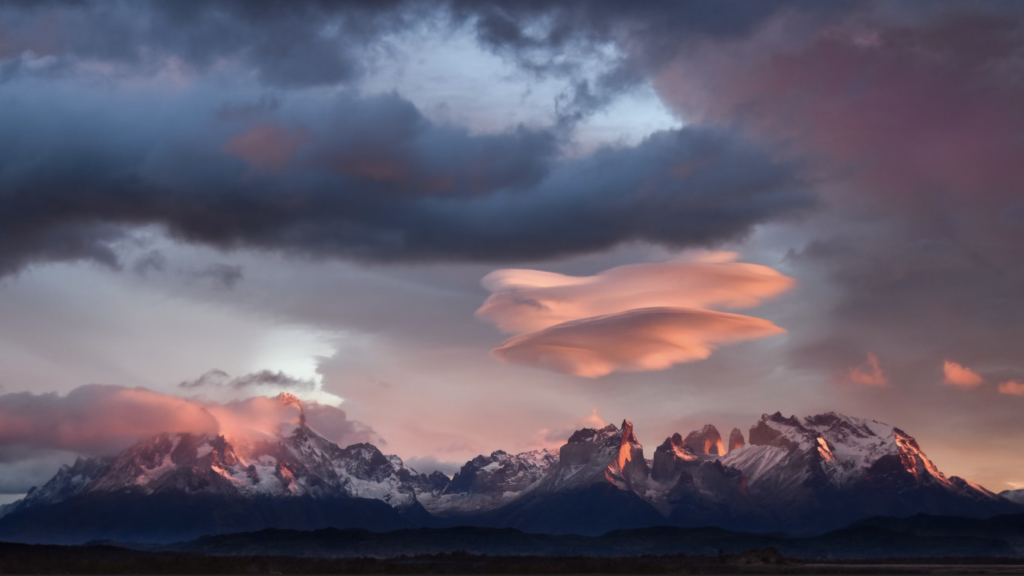
Weather in Patagonia
The weather in Patagonia is famously unpredictable, and understanding its patterns is vital for planning your trek. You can experience all four seasons in a single day, any day of the year. As Patagonia’s weather can change rapidly, you must come prepared with appropriate gear for all conditions.
Proper preparation is key to a successful hike. While the information below acts as a useful guide, local ranger stations will be an invaluable resource for up-to-date weather forecasts and safety advice.
Summer (December-February)
- Summary: December through February marks the peak hiking season in Patagonia. This period is considered the most favorable time for travelers to explore the region due to milder weather and longer daylight hours. Fierce winds are common, sometimes reaching up to 120km/hour.
- Weather: During this time, temperatures are at their warmest and typically range from 15°C to 24°C (60°F to 70°F). The weather is relatively more stable and less extreme.
- Daylight: The days are long, providing ample daylight for exploration. This is especially important for trekkers who need sufficient daylight for their adventures.
- Crowds: Patagonia can get crowded during the peak season, especially in popular national parks and trekking areas. If you prefer a quieter and more secluded experience, you might want to explore less-visited regions or consider visiting during the shoulder season.
- Precipitation: Occasional precipitation, but typically less frequent and intense than in autumn. There are also reduced chances of snowfall.
- Trail accessibility: The majority of the trekking routes, including popular ones like the W Trek in Torres del Paine National Park, are fully accessible and well-marked during the peak season. Trails are less likely to be affected by snow and ice, making hiking conditions more manageable.
- Wildlife: Peak season coincides with the breeding and nesting seasons for many of Patagonia’s wildlife species. It’s an excellent time for birdwatching and observing animals like guanacos, foxes, condors, and even penguins along the coast.
Autumn (March-April)
- Summary: Autumn offers a quieter alternative to the bustling summer season. Hiking in Patagonia over this shoulder season will provide a quiet and unique experience.
- Weather: Slightly cooler temperatures than summer, with daytime temperatures ranging from 8°C to 15°C (46°F to 59°F) on average. The wind is also milder. However, temperatures can still drop significantly at night, so packing warm layers is essential.
- Daylight: Daylight hours start to decrease as autumn progresses. You can expect around 10 to 12 hours of daylight in March and slightly less in April. While this means shorter daylight for activities, it can also lead to stunning sunrise and sunset opportunities.
- Crowds: One of the significant advantages of traveling in Patagonia during March to April is the reduced number of tourists. The peak season crowds have mostly dissipated, making it easier to find accommodations and enjoy the wilderness in a quieter, more contemplative atmosphere.
- Precipitation: Higher levels of precipitation are possible, so waterproof gear is advisable. Additionally, some areas may experience the first snowfalls of the season, particularly in late April.
- Trail accessibility: Many trekking routes and trails remain accessible during March and April, but the conditions can be more challenging due to cooler temperatures and potential rain or snow. Some higher-altitude trails may become less accessible as snow accumulates.
- Wildlife: Patagonia’s wildlife remains active during the autumn months. You may have opportunities to see animals like guanacos, foxes, and birds as they prepare for the winter season. Additionally, this time of year can be ideal for birdwatching, as migratory species pass through the region.
Spring (September-November)
- Summary: Spring is an excellent time to explore Patagonia, as the region awakens from winter but before the tourist rush. During this time, you’ll witness the landscapes coming to life with blooming flowers and newborn wildlife. However, the weather can be quite variable and trails may still have some remnants of snow and mud.
- Weather: Spring in Patagonia is characterized by gradually warming temperatures. Daytime temperatures typically range from 8°C to 15°C (46°F to 59°F) in September and can reach 15°C to 20°C (59°F to 68°F) in November. However, be prepared for chilly nights, especially in September when temperatures can drop significantly.
- Daylight: Daylight hours increase as spring progresses. In September, you can expect around 11 to 13 hours of daylight, while in November, there are approximately 15 hours of daylight. Longer daylight hours provide more time for outdoor activities.
- Crowds: Traveling during spring allows you to avoid the peak summer crowds. While some tourists may start arriving in November, the region remains relatively uncrowded compared to the December to February period.
- Precipitation: Precipitation levels can vary, but spring tends to be less rainy than the autumn months. You may still encounter occasional rain showers, especially in September, so having waterproof gear is advisable. As the season progresses, rain becomes less frequent.
- Trail accessibility: Trail conditions in early spring can be challenging, with some lingering snow and muddy sections in higher-altitude areas. As the season advances, trails become more accessible and drier. Popular trekking routes like the W Trek are generally open, but it’s essential to check trail conditions and be prepared for variable terrain.
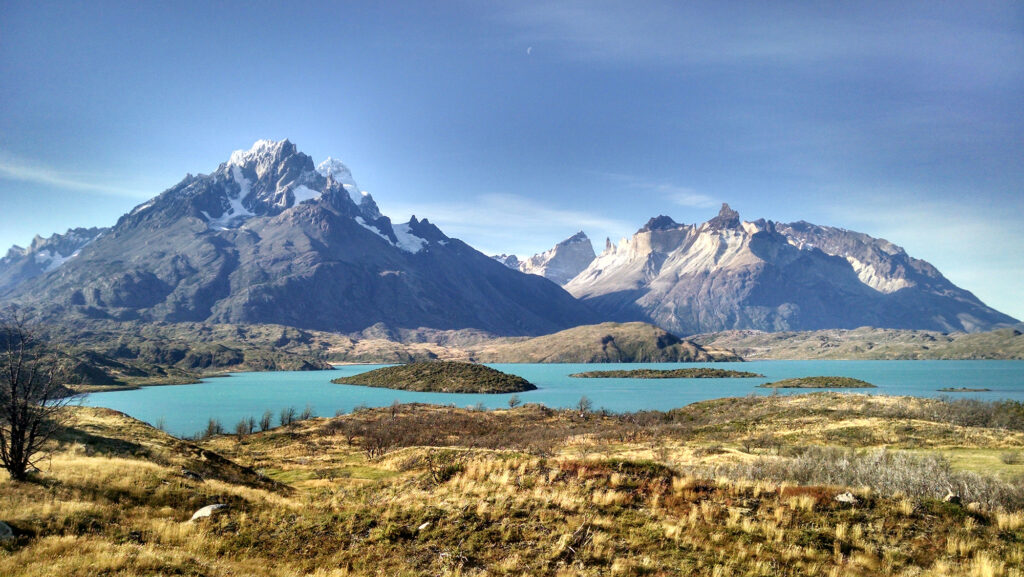
How Many Days Does it Take to go Hiking in Patagonia?
Determining the ideal duration for your Patagonian adventure depends on several factors, including your interests, fitness level, and the specific trails you plan to hike. Patagonia offers a wide range of hiking options, from day hikes to multi-day treks. Here’s a general guideline to help you plan:
- Day Hikes: If you have limited time or prefer a more relaxed experience, day hikes can be incredibly rewarding. Many of Patagonia’s iconic trails, such as Laguna de Los Tres in El Chaltén or Mirador Las Torres in Torres del Paine, can be completed in a day.
- Multi-Day Treks: For a more immersive experience, consider embarking on multi-day treks. The duration can vary significantly depending on the trail. The popular W Trek in Torres del Paine typically takes 4-5 days, while the more extensive O Circuit can span 6-9 days.
- Combination: To make the most of your visit, consider a combination of day hikes and multi-day treks. This approach allows you to explore the highlights while also delving deeper into the wilderness.
Remember that travel times between hiking destinations, rest days, and acclimatization are factors to consider when determining the duration of your Patagonian adventure. It’s advisable to plan for some flexibility in your itinerary, allowing you to fully immerse yourself in the stunning landscapes and unexpected discoveries that Patagonia has to offer.
Building in extra days also allows you to adjust your plans based on adverse weather conditions. Spending an extra night or two in a warm hostel, instead of braving the rain on a multi-day hike to ensure you keep to your itinerary, can make all the difference!
Getting to Patagonia
Patagonia spans both Chile and Argentina, and its vast wilderness is located in the southern reaches of these countries. Here’s a guide to help you reach Patagonia efficiently:
1. International Airports:
- Santiago, Chile: Many travelers fly into Santiago, Chile, for international arrivals.
- Buenos Aires, Argentina: Buenos Aires, Argentina, is another common international gateway to Patagonia.
2. Domestic Flights:
- Punta Arenas, Chile: If arriving in Santiago, consider taking a domestic flight to Punta Arenas, Chile, to minimize travel costs and time.
- El Calafate, Argentina: If departing from Buenos Aires, domestic flights to El Calafate, Argentina, offer convenience.
3. Bus Transportation:
- Connecting to Main Trekking Areas: Upon arriving in southern Patagonia, efficient and affordable bus transportation is readily available to connect you to the main trekking areas.
Hiking In Torres del Paine National Park
Now that we’ve covered essential planning aspects, let’s dive into the heart of Patagonia: Torres del Paine National Park. This iconic destination offers some of the most breathtaking hikes in the region. You can access the park via Puerto Natales.
Hiking to Mirador Las Torres
- Time Required: 8 to 9 hours
- Distance: 18km
- Difficulty: Moderately challenging with steep sections
- Start / Finish Points: Hotel Las Torres
- Highlights: Witness the famous Torres del Paine towers mirrored in the glacial lake
One cannot speak of hiking in Patagonia without mentioning Torres del Paine National Park. A must-visit for any trekking enthusiast, the Mirador Las Torres trail offers a challenging but immensely rewarding day hike. The path spans 18 kilometers and leads to the iconic Towers – three jagged peaks overlooking a turquoise lake. The last leg of the hike is steep, but the views are absolutely breathtaking. If you’re an early riser, consider starting before dawn to witness the iconic granite spires bathed in the fiery glow of sunrise.
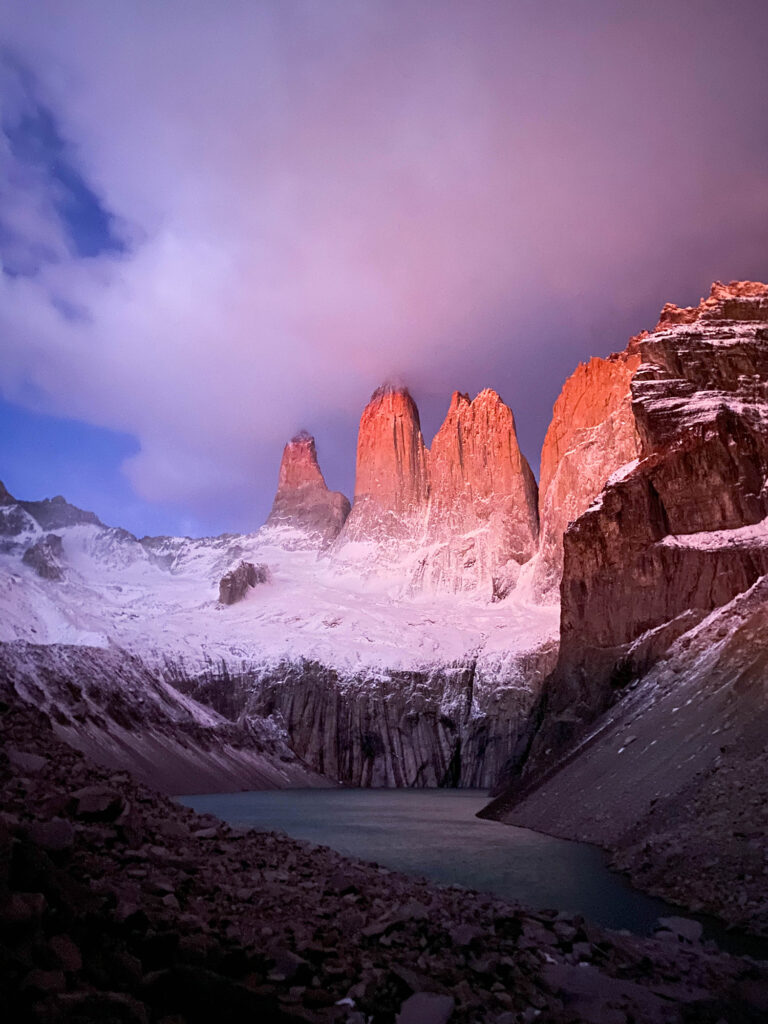
Lago Grey (Grey Glacier)
- Time Required: 3 to 4 hours
- Distance: 11 kilometers
- Difficulty: Easy to moderate
- Start / Finish Points: Mountain Lodge Paine Grande to Refugio Grey
- Highlights: Get up close to Grey Glacier’s stunning ice formations and ethereal blue glacier
For those craving a more relaxed hike with stunning glacier views, the Lago Grey trail is perfect. This 11-kilometer route takes you along the W Trek, offering glimpses of the awe-inspiring Glaciar Grey and its floating icebergs. The terrain is relatively easy, with a few tricky sections. If you’re in the mood for camping, you can spend the night at Mountain Lodge Paine Grande or Refugio Grey and enjoy the serene surroundings.
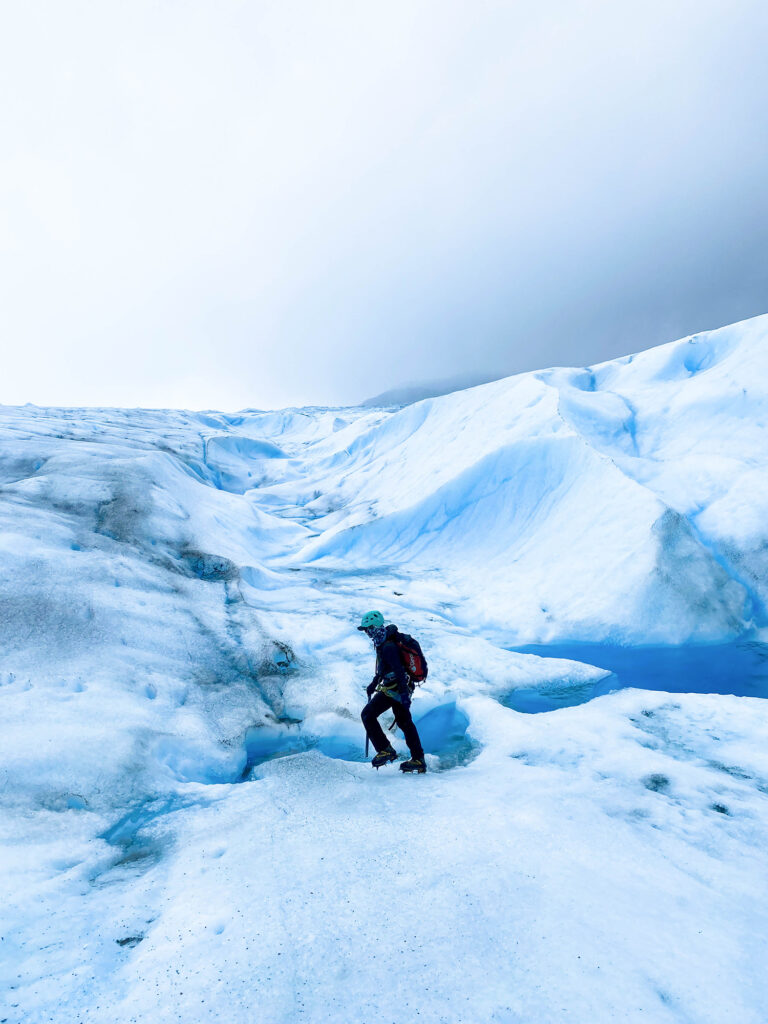
Valle del Frances (The French Valley)
- Time Required: 3 to 4 hours
- Distance: 12km
- Difficulty: Moderate
- Start / Finish Points: Refugio Los Cuernos
- Highlights: Jaw-dropping vistas of the granite peaks and hanging glaciers
Prepare to be mesmerised by the beauty of the French Valley, which offers breathtaking panoramic views of the Paine Massif. This moderate hike takes you between Cerro Paine Grande and Cuernos del Paine, following the Rio Frances. The highlight of this trail is the frozen waterfalls, a sight to behold. Although the path can be challenging, the rewards are ample. The Mirador at the end provides breathtaking views of the surrounding mountains and tarns reflecting the scenery.

Los Cuernos Trail
Offering a fantastic day hike, the Los Cuernos Trail winds its way around the stunning Lago Nordenskjold. You’ll be treated to incredible vistas of Cuernos del Paine and the lake’s clear waters. For those with extra energy, consider exploring the Valle del Frances, an additional 12-kilometer section known for its beauty. Camping options are available on the south side of Cuernos Del Paine if you want to extend your hike.
- Time Required: 6 hours
- Distance: 22km
- Difficulty: Moderate
- Start / Finish Points: Hotel Las Torres to Refugio Los Cuernos
- Highlights: Diverse landscapes and stunning views of the Cuernos del Paine

The W Trek
- Time Required: 4 to 5 days
- Distance: Approximately 50-70 kilometers (31-44 miles)
- Difficulty: Moderate to challenging, with steep ascents and variable weather.
- Start / Finish Points: Typically, the trek begins and ends at the administrative center of Torres del Paine National Park, near Laguna Amarga.
- Highlights: The “W” Trek in Torres del Paine National Park encompasses Mirador Las Torres, Lago Grey, the French Valley, and Los Cuernos, making it a comprehensive hiking experience.
Hiking the W Trek in Torres del Paine National Park is a bucket-list adventure for nature enthusiasts, offering a chance to immerse yourself in Patagonia’s pristine wilderness and witness some of the world’s most awe-inspiring natural wonders. You can also go ice hiking on Grey Glacier, a unique and unforgettable experience. Various accommodation options are available along the route, including campsites and mountain lodges (refugios). Reservations should be made in advance, especially during the high season. Plan ahead, pack appropriately, and embark on this unforgettable journey through Chile’s breathtaking landscapes.
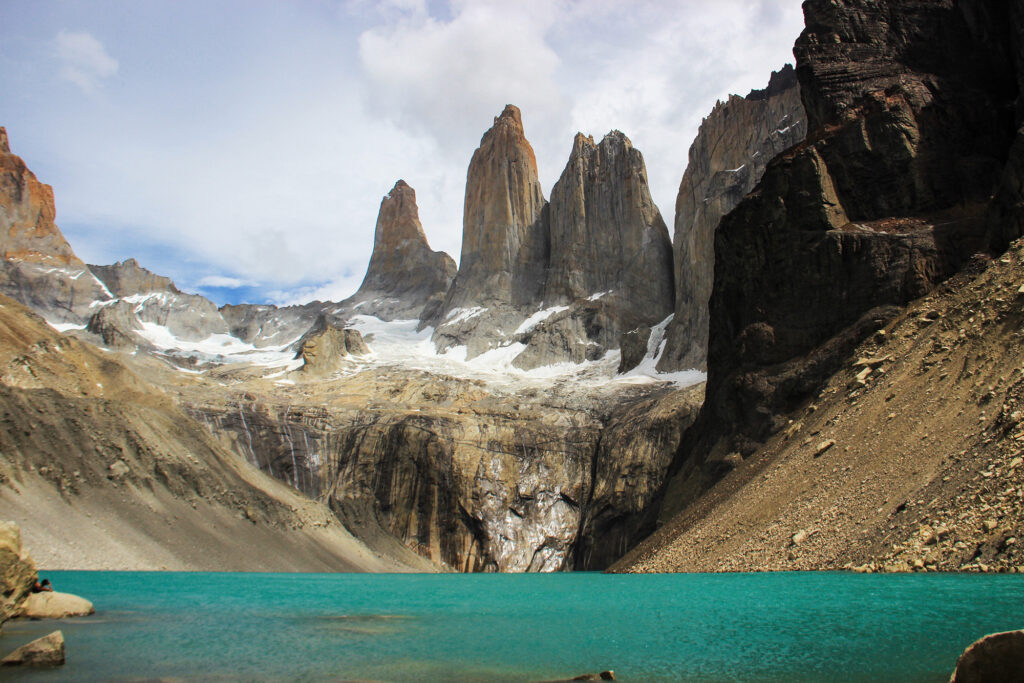
The O Circuit
- Time Required: 6-8 days
- Distance: 135km
- Difficulty: Hard
- Start / Finish Points: Hotel Las Torres
- Highlights: In addition to the sights of the W Trek, you will also see John Gardner Pass, Grey Glacier Peninsula, Paso los Perros
Considered one of the world’s best treks, the O Circuit is a must for adventurous souls. It is an extension of the W Trek, following the same trail for 4-5 days before continuing in a loop. It is a more remote, immersive wilderness experience that takes you deeper into Torres del Paine National Park.
This 135-kilometer circuit encompasses pristine forests, meadows of wildflowers, grand peaks like Cerro Paine and Cuernos del Paine, and even the iconic Las Torres. Starting at Hotel Las Torres and heading to Campamento Seron, you’ll encounter ever-changing landscapes and breathtaking scenery. Side trips to the French Valley and Las Torres are highly recommended, and you can finish your journey at Mountain Lodge Paine Grande or Lago del Toro.
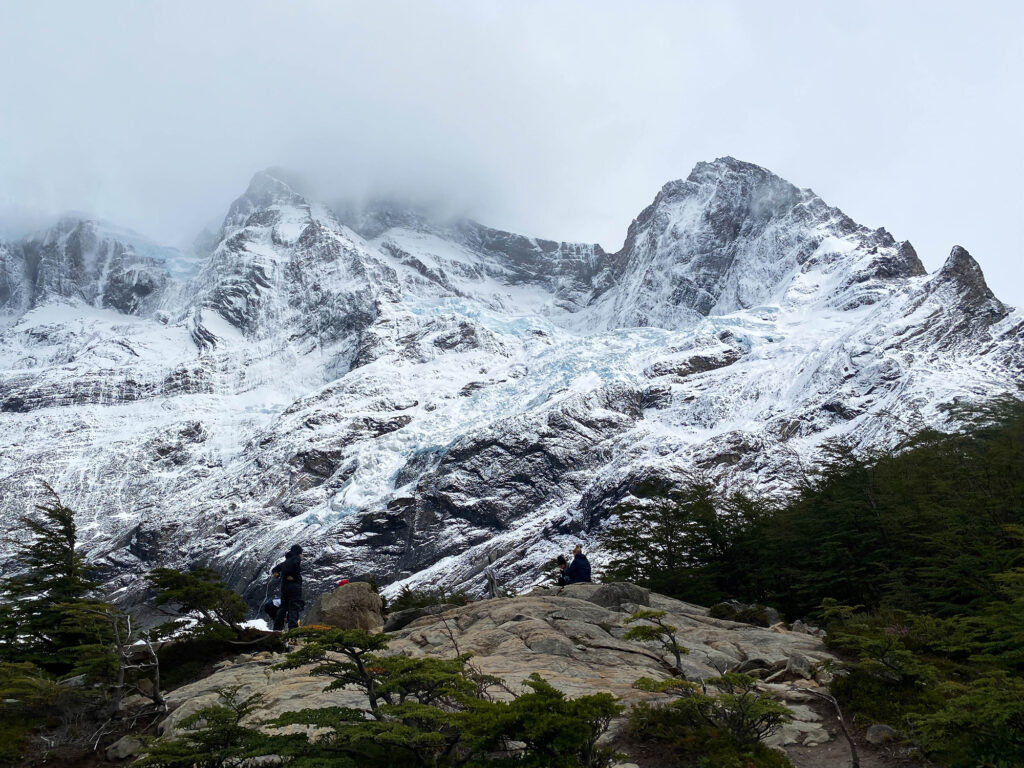
Hiking in El Chalten
While Torres del Paine is undeniably stunning, El Chalten has its own charm. It is a beloved destination for backpackers, offering unparalleled hiking opportunities amid stunning landscapes. Here are some of the best hikes in El Chalten.
Short Hike to Condor Lookout
- Time Required: 1 hour
- Distance: 2km
- Difficulty: Easy
- Start / Finish Points: El Chalten
- Highlights: Panoramic vistas and potential condor sightings
A short but sweet hike, the Condor Lookout offers unexpected views of Viedma Lake framed by snow-covered peaks. This is an excellent option for a sunrise hike, allowing you to witness the alpine glow on the mountains. The trail is gradual, making it accessible for most hikers.
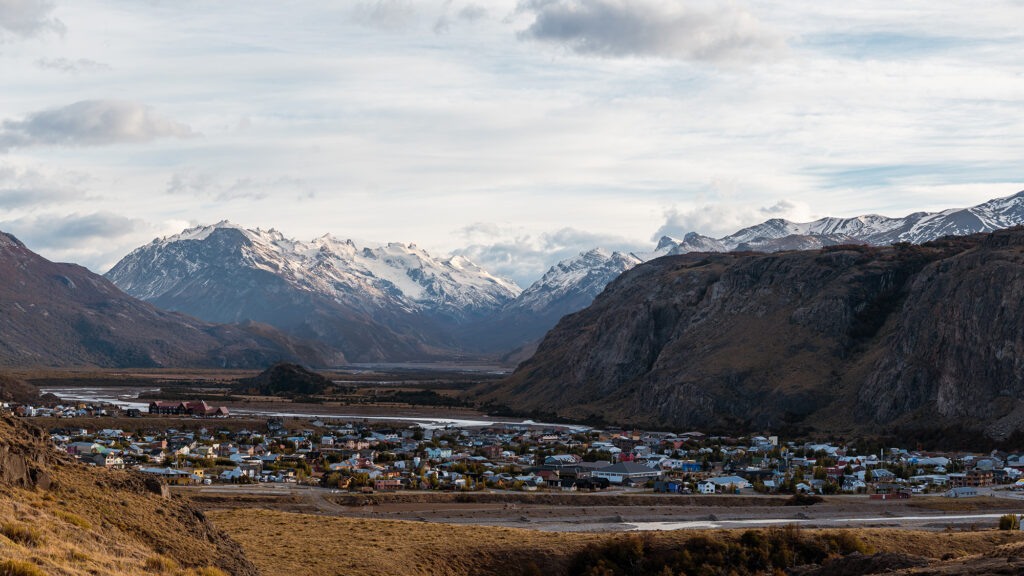
Day Hike to Laguna de Los Tres (Base Of Mt Fitz Roy)
- Time Required: 8 hours
- Distance: 26km
- Difficulty: Moderately challenging with steep sections
- Start / Finish Points: Northwest end of El Chalten
- Highlights: The incredible sight of Mt Fitz Roy mirrored in the lake
You cannot go hiking in Patagonia without visiting Mt Fitz Roy. For those seeking an up-close encounter with Mt Fitz Roy, the Laguna De Los Tres hike is a must. Starting early is advisable to catch the morning alpine glow. The trail begins gently, passing through forests, but the last hour involves a steep ascent. Your reward? The mesmerising Laguna De Los Tres with Fitz Roy towering above. If you’re up for it, consider climbing Cerro Madsen for even better views.
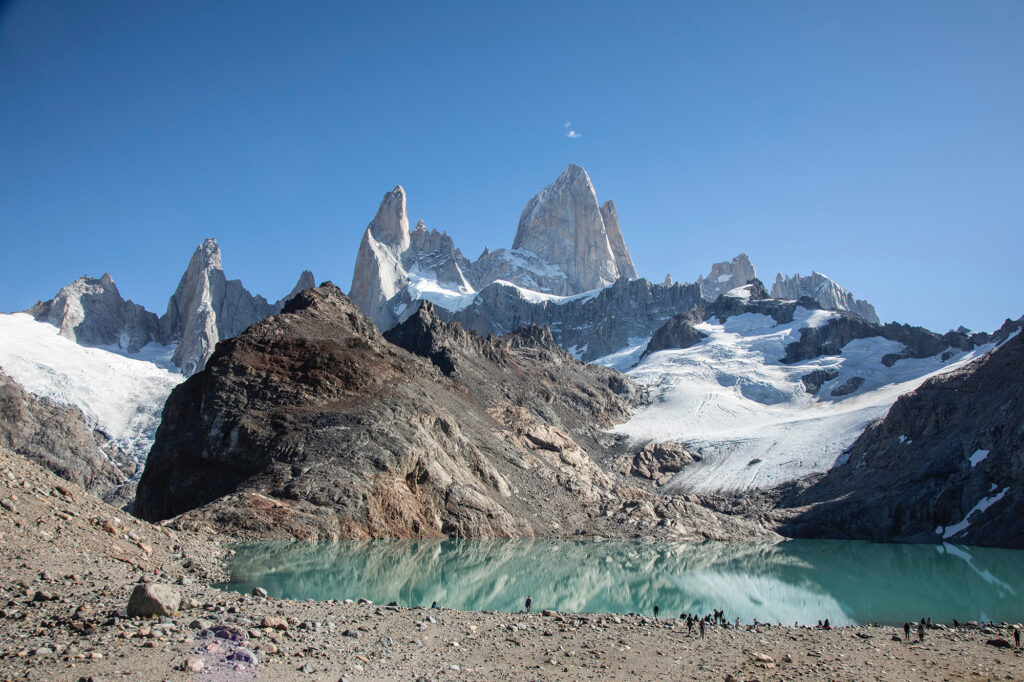
Day Hike to Laguna Suica
- Time Required: 1-2 days (can be done as a day hike)
- Distance: 19km
- Difficulty: Moderate to difficult, with some scrambling and rock climbing required
- Start / Finish Points: El Chalten
- Highlights: Scenic views of Mt Fitzroy and surrounding mountains, looming over a sparkling blue lake, with no crowds!
If you’re looking for expansive views of Mt Fitz Roy without the crowds, this is the hike for you. Instead of taking the ascent to Laguna de Los Tres, veer off the beaten path to Laguna Suica. This option offers arguably better views, and you’re likely to have the whole lake to yourself!
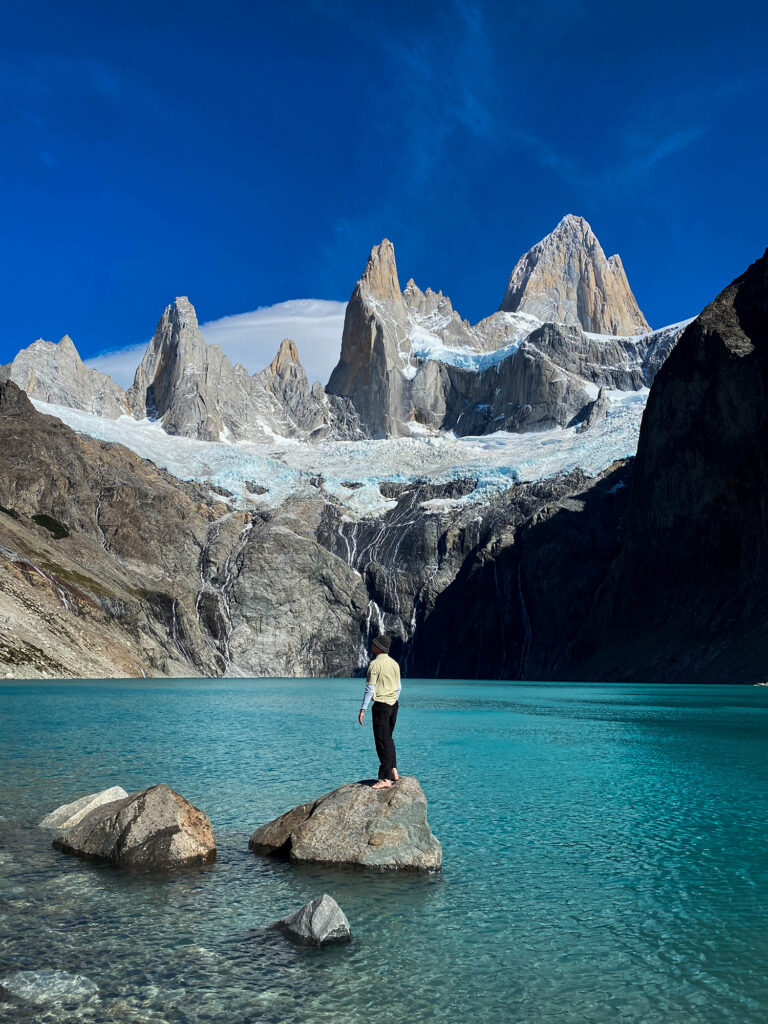
Day Hike to Cerro Torre
- Time Required: 1-2 days (can be done as a day hike)
- Distance: 19km
- Difficulty: Easy
- Start / Finish Points: El Chalten
- Highlights: Views of Cerro Torre and its surrounding spires
Cerro Torre, reaching 3102 meters into the sky, is a sight to behold. This 2-day hike takes you through lush meadows, ever-changing glaciers, and offers stunning views of Cerro Torre and its neighboring peaks. A side trip to Mirador Maestri adds even more beauty to your journey. Return the same way you came, or camp at Campamento de Agostini for an immersive experience.
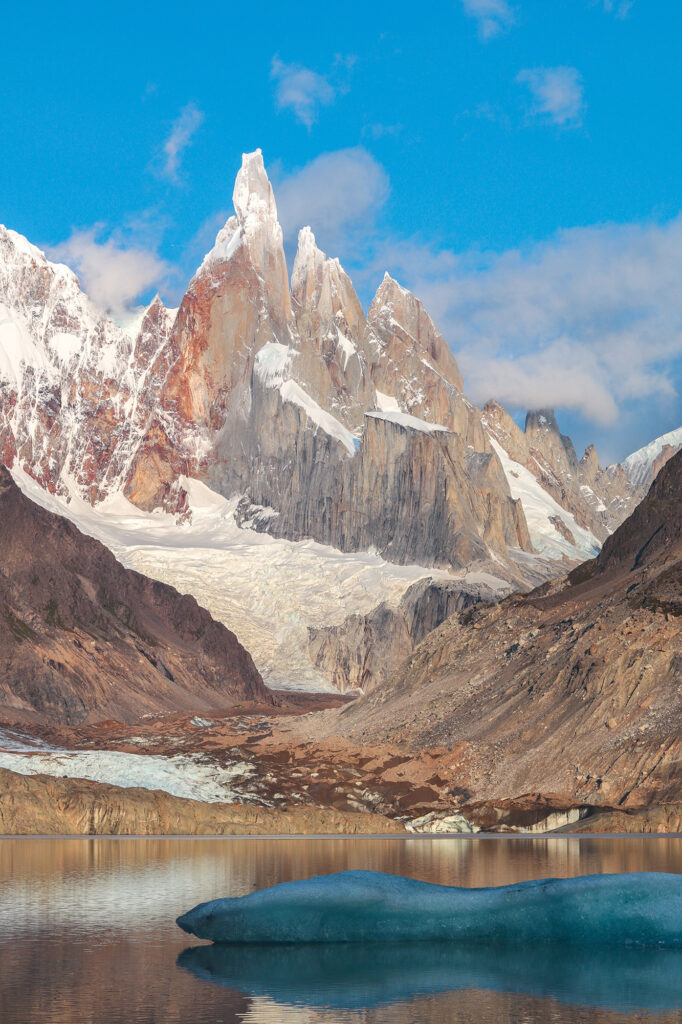
The Huemul Circuit
- Time Required: 4 days
- Distance: 63km
- Difficulty: Difficult, for advanced hikers
- Start / Finish Points: El Chalten
- Highlights: Panoramic views of Southern Patagonia, including Laguna Toro, Paso del Viento, Paso Huemul and Lake Viedma
The Huemul Circuit is not for the faint of heart, but it rewards intrepid hikers with a unique Patagonian experience. This trek takes you through breathtaking landscapes, including the majestic Mount Huemul and the Southern Patagonian Ice Field. It is known for its challenging terrain, river crossings, and rugged paths.
It’s a trek for those seeking adventure, and the relative isolation of the route ensures a sense of solitude and connection with the wilderness.
While hiking the Huemul Circuit, you may encounter a variety of wildlife, including guanacos, condors, foxes, and numerous bird species. The trek also takes you through diverse ecosystems, from lush forests to alpine meadows.
Be prepared for a difficult hike, but the views are worth every effort. Hiring a local guide is advisable for this demanding trek.
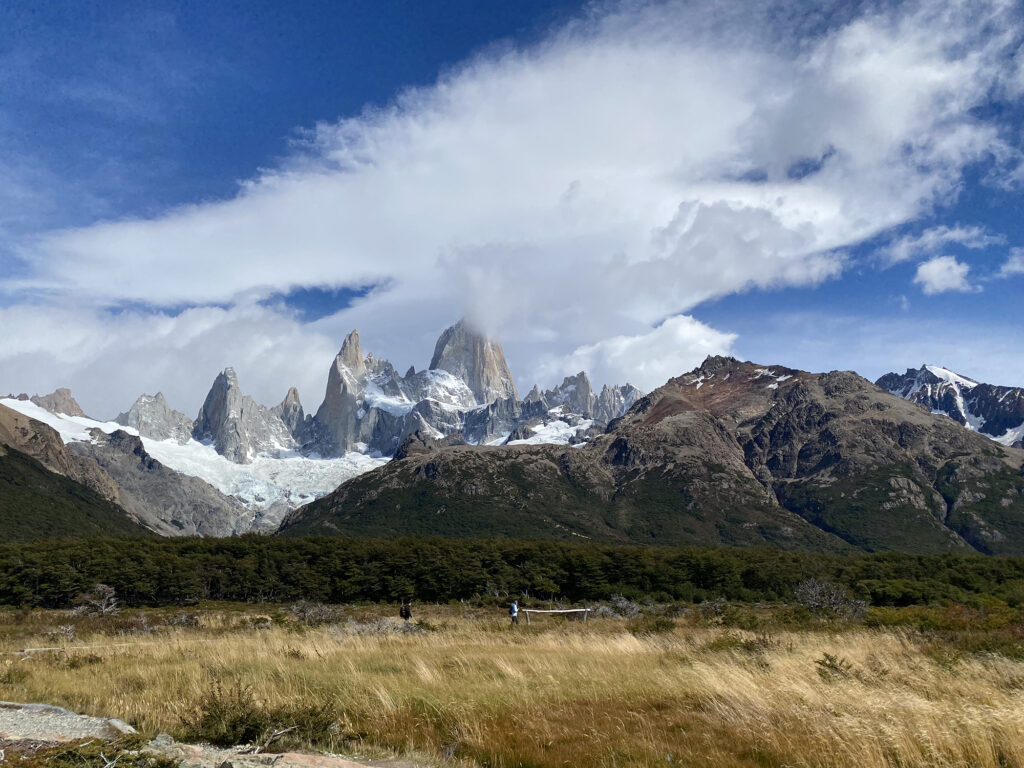
Best Hikes in Ushuaia
Located at the southernmost tip of Argentina, Ushuaia is known as ‘the end of the world’. It is the furthest of your options when hiking in Patagonia, but the views are totally worth it. Besides being a gateway to Antarctica, it offers some fantastic treks.
Laguna Esmeralda
- Time Required: 3 to 4 hours
- Distance: 9km
- Difficulty: Easy
- Start / Finish Points: Refugio Valle Los Lobos
- Highlights: The stunning emerald-colored lake and surrounding landscapes
For a short but sweet hike, Laguna Esmeralda is a striking turquoise lake nestled amidst snow-capped peaks. This 9-kilometer trail leads to the base of Glaciar Del Albino, with an option to continue onto the glacier if you’re up for it. The refugio near the lake allows you to soak in the stunning views.
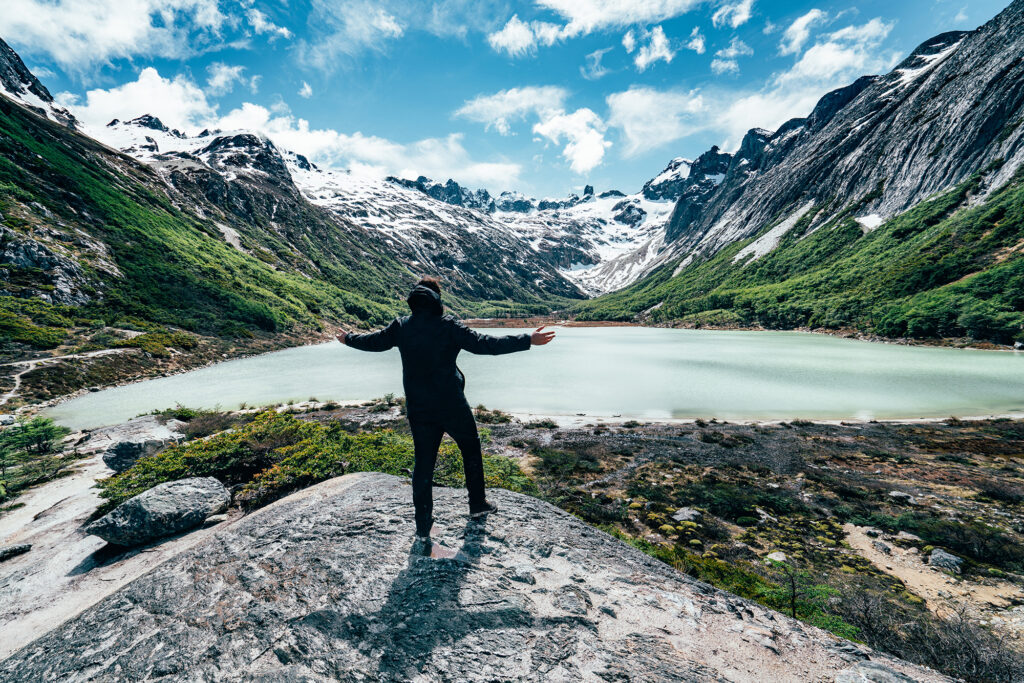
Glaciar Vinciguerra
- Time Required: 5 to 6 hours
- Distance: 13km
- Difficulty: Moderate
- Start / Finish Points: Tubera Valle Andorra
- Highlights: Close encounter with a glacier and pristine alpine scenery
The Glaciar Vinciguerra trek takes you to a series of glacial lakes with steep ascents, making it a satisfying challenge for a day hike. You’ll encounter Laguna Encatada, surrounded by lush meadows and rugged peaks. If you’re feeling adventurous, climb Cerro Esfinge for even better views.
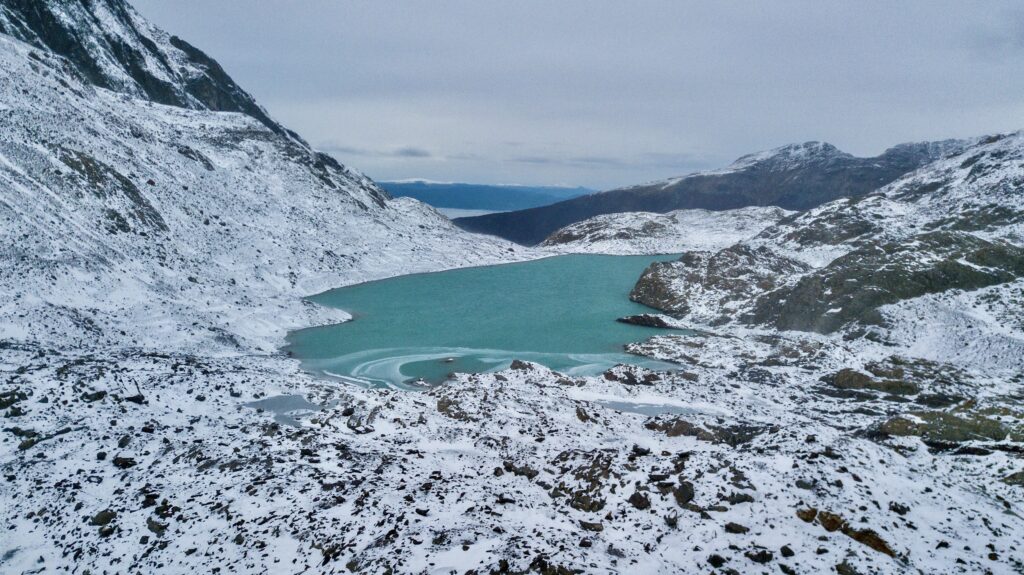
Sierra Valdivieso Circuit
- Time Required: 4 days
- Distance: 48.5km
- Difficulty: Demanding
- Start / Finish Points: Ruta Nacional 3 or Posada del Peregrine
- Highlights: A multi-day trek encapsulating all the highlights of Ushuaia
Deep within the Fuegian Andes lies the Sierra Valdivieso Circuit, one of the most challenging treks in Argentina. This trek takes you through snowy peaks, glaciers, and crystal-clear lakes. The trail is less traveled, so good navigation skills are essential. Due to unpredictable weather, carry extra supplies.
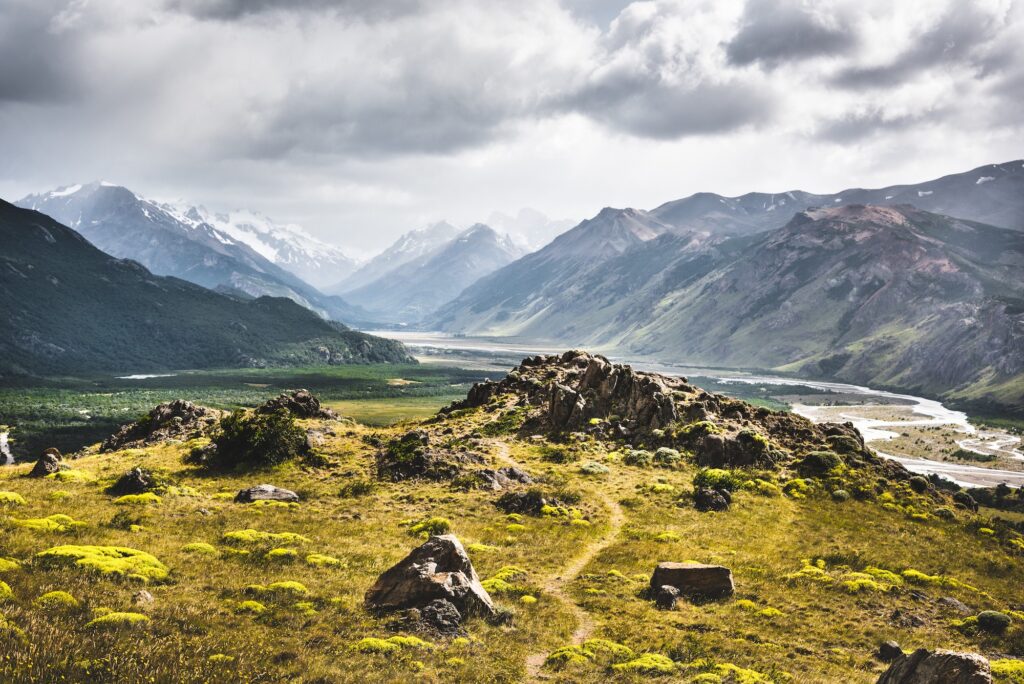
Best Hikes Along the Carretera Austral
While Patagonia’s most famous hiking destinations are often found in the well-known national parks and reserves, the Carretera Austral offers a unique opportunity to explore some of the region’s less-traveled trails. This remote highway stretches over 1,240 kilometers, running through the heart of Chilean Patagonia. Along the way, you’ll encounter a variety of off-the-beaten-path hiking experiences.
Laguna Tigre Sur
- Time Required: About 4 to 5 hours
- Distance: 8km
- Difficulty: Moderate
- Start / Finish Points: Villa O’Higgins
- Highlights: Remote and pristine landscape with the chance to spot wildlife
Located in the pristine Pumalin Park, the hike to Laguna Tigre Sur is a hidden gem. This relatively short trail takes you through lush temperate rainforests, offering glimpses of Patagonia’s diverse flora and fauna. The reward at the end is the serene Laguna Tigre Sur, a tranquil lake surrounded by ancient forests. The area’s remoteness ensures a peaceful and immersive experience.
Valle Rio Moscu
- Time Required: About 5 to 7 hours
- Distance: 13km
- Difficulty: Moderate
- Start / Finish Points: Villa O’Higgins
- Highlights: Lush valleys and beautiful river views
Deep within the Aysen region, Valle Rio Moscu offers an enchanting trek through pristine wilderness. This valley is known for its stunning scenery, including dramatic waterfalls, lush forests, and crystal-clear rivers. The trail takes you along the Moscu River, surrounded by towering peaks and glaciers. Be prepared for challenging river crossings, but the breathtaking views make it all worthwhile.
Cerro Castillo
- Time Required: 3 to 5 days, depending on the route
- Distance: 62km
- Difficulty: Moderate to challenging
- Start / Finish Points: Las Horquetas Grandes to Villa Cerro Castillo
- Highlights: Stunning mountain scenery and pristine wilderness
While Cerro Castillo is often associated with its well-known reserve, you can also explore its lesser-known and equally spectacular trails. The Cerro Castillo trek takes you through lush forests, across pristine rivers, and up to high alpine meadows. The reward is the stunning view of Cerro Castillo’s jagged peaks and glaciers. This trek is a fantastic alternative for those looking to avoid the crowds while still enjoying the beauty of the region.
Pumalin Park – Cascadas Waterfalls Hike (Escondidas)
- Time Required: 1 to 2 hours
- Distance: 3.5km
- Difficulty: Easy
- Start / Finish Points: Caleta Gonzalo
- Highlights: Remarkable nature reserve with cascading waterfalls
Pumalin Park is a true wilderness paradise, and the Cascadas Waterfalls Hike is a prime example of its natural beauty. This trail leads you through dense forests, alongside pristine rivers, and to a series of cascading waterfalls. The lush vegetation, combined with the sounds of rushing water, creates a magical atmosphere. While the hike itself is not particularly long or strenuous, it offers a peaceful escape into the heart of Patagonia.
Planning Your Hike in Patagonia
Can You Hike Patagonia on Your Own?
Choosing between independent or guided trekking depends on your experience and personal preferences. If you’re an experienced backpacker tackling a well-traveled route like the W Trek or hikes around Fitz Roy, independent hiking is entirely feasible. These trails are well-marked, and with proper planning, you can have a successful journey. However, meticulous preparation is essential, including booking campsites in advance.
For those seeking a more guided experience or exploring less-traveled routes, organized tours provide valuable support and expertise. Guided tours handle logistics, navigation, and safety measures, allowing you to focus on enjoying the scenery and adventure. Let’s explore the pros and cons of both options.
Hiking in Patagonia Independently (incl. Solo Hiking)
Pros:
- Freedom: Hiking independently allows you to set your own pace and explore as you wish.
- Cost: It’s generally more budget-friendly than guided tours.
- Self-Discovery: You’ll gain valuable wilderness skills and self-sufficiency.
Cons:
- Navigational Challenges: Patagonia’s trails can be challenging to navigate, and weather conditions can change rapidly.
- Safety: In remote areas, getting help in emergencies can be difficult.
- Logistics: Planning routes, permits, and accommodations can be time-consuming.
Hiring a Guide for Patagonia (incl. Group Tours)
Pros:
- Expertise: Guides offer in-depth knowledge of the terrain, flora, fauna, and local culture.
- Safety: They are trained in wilderness first aid and can respond to emergencies.
- Logistical Support: Guides handle permits, accommodations, and meal planning.
Cons:
- Cost: Guided tours are more expensive due to the added services.
- Less Freedom: You’ll follow a predefined itinerary.
Ultimately, the decision comes down to your experience, comfort level, and objectives. Experienced hikers with wilderness navigation skills may relish the freedom of independent trekking. However, if you’re new to Patagonia or prefer a structured experience, hiring a guide can enhance your adventure and safety.
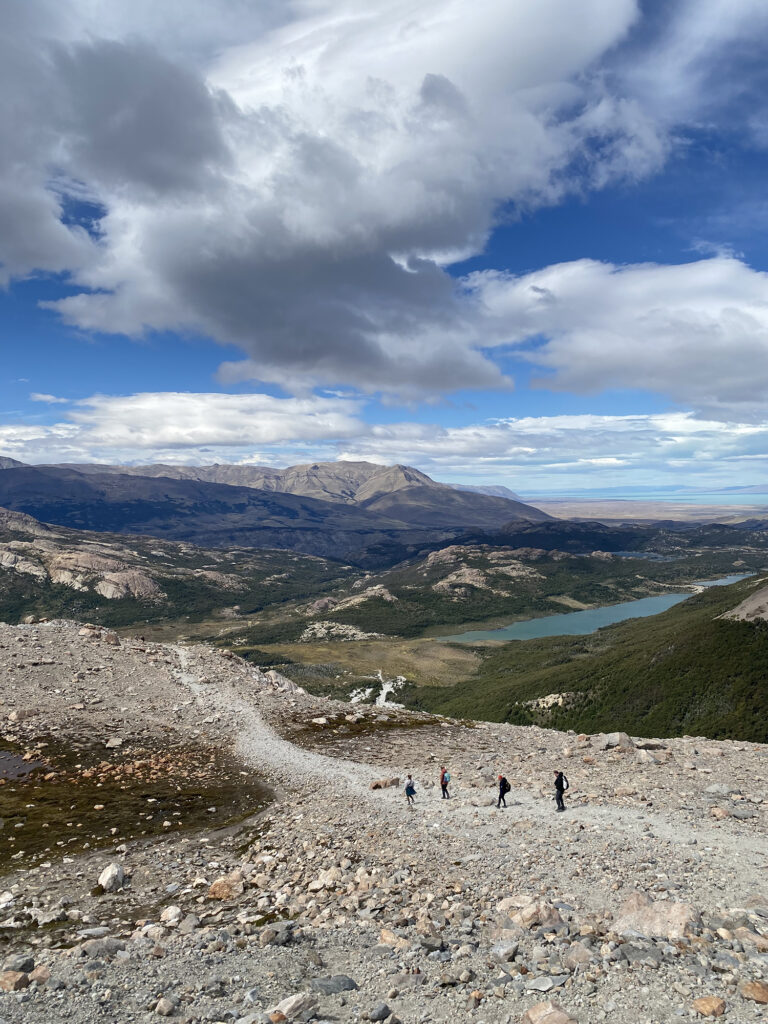
Is Hiking in Patagonia Difficult?
Patagonia’s hiking trails offer varying levels of difficulty, from relatively easy day hikes to challenging multi-day treks. The difficulty of your hike depends on factors such as trail conditions, terrain, and weather. Here’s a breakdown:
- Easy Hikes: Short, well-marked trails with minimal elevation gain, suitable for beginners and families. Examples include Laguna Esmeralda and Condor Lookout.
- Moderate Hikes: Longer day hikes or multi-day treks with moderate elevation gain and varied terrain. Trails like the W Trek and Cerro Torre fall into this category.
- Challenging Hikes: Multi-day treks with significant elevation changes, steep ascents or descents, and unpredictable weather. The O Circuit and Huemul Circuit are more challenging options.
- Technical Hikes: Some routes may involve technical climbing or glacier travel, requiring specialized skills and equipment. Seek guidance from experts for these adventures.
It’s crucial to choose hikes that match your fitness level and experience. Beginners can enjoy many fantastic trails in Patagonia with the right preparation and gear.
Can Beginners Go Hiking in Patagonia?
Yes, beginners can certainly enjoy hiking in Patagonia, but it’s essential to plan appropriately and choose suitable trails. Here are some tips for novice hikers:
- Select Easy to Moderate Trails: Start with shorter and less challenging hikes that match your fitness level. Laguna Esmeralda, Condor Lookout, and the short hikes in Torres del Paine are excellent options.
- Prepare Physically: Begin a fitness routine that includes cardiovascular and leg-strengthening exercises to build endurance for hiking.
- Acclimate: If possible, spend a day or two in a nearby town like Puerto Natales or El Calafate to acclimate to the altitude and climate.
- Gear Up: Invest in proper hiking gear, including waterproof and insulated clothing, sturdy hiking boots, and trekking poles for stability.
- Travel Light: Keep your backpack as light as possible to reduce the strain on your body.
- Plan Adequate Time: Allocate extra time for rests and adjustments to the pace, especially if you’re not accustomed to hiking.
- Stay Informed: Check trail conditions, weather forecasts, and park regulations before embarking on your hike.
- Travel with a Group: If you’re uncertain about your hiking abilities, consider joining a guided tour or traveling with experienced hikers.
Remember that safety should be a priority, and it’s better to start with easier hikes and gradually progress to more challenging trails as you gain confidence and experience.
Cost of Hiking in Patagonia
It’s important to note that Patagonia is not a budget-friendly destination compared to other South American locations. Expect higher costs for lodging, food, and various amenities. However, there are options to save money. Some factors influencing the cost of your trip include duration, accommodation preferences, and whether you hire a guide. Here’s a breakdown of potential expenses:
- Flights: International and domestic flights to Patagonia can be a significant expense, so booking in advance and searching for deals is advisable.
- Accommodation: Options range from camping (cheapest) to hostels, cabins, and luxury lodges (more expensive). Prices increase during peak seasons.
- Park Fees: Most national parks in Patagonia charge entrance fees. The costs vary, so check with each park for updated prices.
- Food: Dining out in Patagonia can be pricey, especially in remote areas. Consider bringing some of your own food for longer treks to save money.
- Gear and Equipment: Investing in quality hiking gear, clothing, and camping equipment can be expensive upfront but pays off in comfort and safety.
- Guides: Hiring a guide or joining a guided tour adds to the cost but provides expertise and logistical support.
- Transportation: Transportation within Patagonia, such as buses or boats, will contribute to your expenses.
- Miscellaneous: Budget for additional expenses like permits, travel insurance, and souvenirs.
It’s possible to go hiking in Patagonia on a tight budget by camping, preparing your own meals, and choosing less expensive accommodations. Conversely, those seeking more comfort and convenience can opt for guided tours and upscale lodging. Careful planning and budgeting will help you make the most of your Patagonian adventure within your financial means.
How Safe is Hiking in Patagonia?
Hiking in Patagonia offers incredible experiences, but it’s essential to prioritise safety due to its remote and challenging nature. Here are some safety considerations:
- Weather: Be prepared for rapidly changing weather conditions. Carry adequate clothing, rain gear, and layers to stay warm and dry.
- Navigation: Trails can be poorly marked, and getting lost is a risk. Carry maps, a compass, and a GPS device, and know how to use them.
- Wildlife: Patagonia is home to various wildlife, including pumas. Understand how to react if you encounter animals and store food securely.
- Altitude: Some hikes reach high altitudes. Acclimatize gradually and be aware of symptoms of altitude sickness.
- Water: Water sources can be contaminated. Use water treatment methods to ensure safe drinking water.
- Emergency Contact: Inform someone of your itinerary and expected return time. Cell phone coverage can be limited.
- Health: Ensure you have any necessary medications and a basic first aid kit. Be prepared for minor injuries and know basic first aid.
- Group Travel: Traveling with others or hiring a guide can enhance safety, especially for beginners.
- Local Advice: Seek advice from local rangers and experts who can provide up-to-date information on trail conditions and safety concerns.
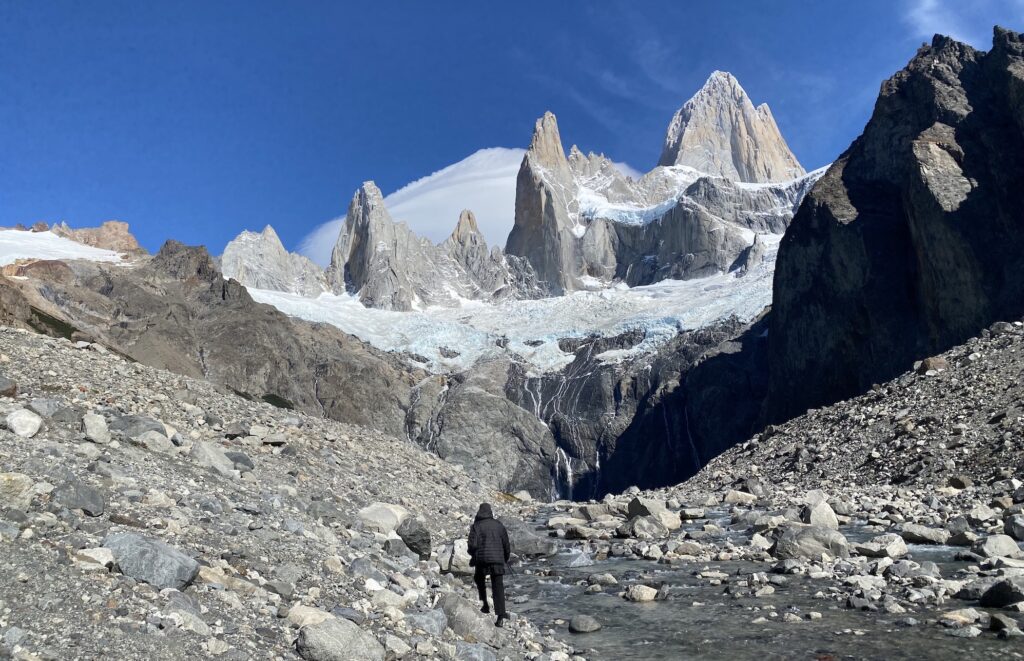
Hiking in Patagonia Packing List
Before you embark on your Patagonian adventure, it’s essential to have the right gear and supplies to ensure a safe and enjoyable journey. Here’s a comprehensive packing list to help you prepare for trekking in Patagonia:
Clothing
- Moisture-wicking base layers (top and bottom)
- Insulating mid-layers (fleece or down jacket)
- Waterproof and windproof outer layer (jacket and pants)
- Quick-drying hiking pants
- Sturdy and comfortable hiking boots
- Warm gloves
- Wool hat or beanie
- Moisture-wicking socks and sock liners
- Gaiters (for keeping debris out of your boots)
- Sun hat and sunglasses
- Bandana or buff (for sun protection)
- Swimsuit (for swimming in thermal pools or lakes)
Backpacking Gear
- Hiking backpack with rain cover (40-70 liters, depending on your trip)
- Tent or lightweight shelter (if camping)
- Sleeping bag suitable for cold weather
- Sleeping pad or mattress
- Cooking stove and cookware (if camping)
- Lightweight utensils, cup, and bowl
- Headlamp or flashlight with extra batteries
- Multi-tool or camping knife
- Lighter or waterproof matches
- Trekking poles (optional but recommended)
- Dry bags or stuff sacks (for organising gear)
- Navigation tools (maps, compass, GPS)
Personal Items
- Passport and any necessary visas
- Travel insurance information
- Cash in local currency (ATMs may be scarce)
- First-aid kit with essential medications
- Toiletries (toothbrush, toothpaste, soap, etc.)
- Microfiber towel
- Insect repellent
- Sunscreen and lip balm with SPF
- Personal identification (ID or driver’s license)
- Camera and accessories
- Charging cables and portable power bank
Food and Water
- High-energy snacks (nuts, energy bars, dried fruit, etc.)
- Dehydrated or freeze-dried meals (if camping)
- Reusable water bottle or hydration reservoir (3+ liters)
- Water purification filter or water purification tablets
Miscellaneous
- Travel itinerary and emergency contact information
- Travel adapters and chargers
- Travel-sized sewing kit
- Ziplock bags (for organizing and waterproofing)
- Trash bags (for packing out waste)
- Local guidebooks or trail maps
- Notepad and pen
- Entertainment (book, playing cards, etc.)
Optional
- Solar charger for electronics
- Binoculars for wildlife viewing
- Travel pillow
- Camp shoes (lightweight sandals or camp slippers)
- Down booties for keeping feet warm in camp
Leave No Trace Principles
When hiking in Patagonia, it’s crucial to adhere to Leave No Trace principles to minimize your impact on the environment. These principles include:
- Plan ahead and prepare: Research your route, obtain necessary permits, and pack appropriately to minimize waste and resource use.
- Travel and camp on durable surfaces: Stick to established trails and campsites to prevent soil erosion and damage to fragile ecosystems.
- Dispose of waste properly: Pack out all trash and waste, including biodegradable items like food scraps and toilet paper.
- Leave what you find: Preserve the natural environment by not picking plants, disturbing wildlife, or removing rocks and historical or cultural artifacts.
- Minimize campfire impact: Use a camp stove for cooking instead of making fires, as fires can scar the landscape and deplete limited wood resources.
- Respect wildlife: Observe animals from a distance, avoid feeding them, and keep a safe distance to prevent stress and harm.
- Be considerate of other visitors: Keep noise levels down, yield the trail to others, and maintain a friendly and respectful attitude towards fellow hikers.
By following these principles, you can help protect the fragile ecosystems of Patagonia and ensure that this pristine wilderness remains a natural wonder for generations to come.
Conclusion
Hiking in Patagonia is a journey into the heart of one of Earth’s most awe-inspiring landscapes. From the towering peaks of Torres del Paine to the hidden treasures of the Carretera Austral, this region offers a diverse range of trails for adventurers of all levels. Whether you choose to hike independently or join a guided tour, careful preparation, respect for the environment, and a sense of wonder are essential companions on your Patagonian trek.
As you embark on your adventure, take the time to savour the beauty of Patagonia, listen to the whispers of the wind, and marvel at the sheer majesty of nature. In this remote corner of the world, you’ll discover not only breathtaking landscapes but also a profound connection to the wild and untamed spirit of Patagonia. So lace up your boots, shoulder your pack, and set out to explore this magnificent land – Patagonia awaits your footprints, and the adventure of a lifetime awaits your spirit.
FAQs
Hiking in Patagonia offers a range of difficulty levels. Some trails are suitable for beginners with minimal elevation gain, while others are more challenging, requiring experience and endurance. Choose trails that match your fitness level and goals.
Yes, beginners can hike in Patagonia. Many trails are beginner-friendly, such as short day hikes and well-marked paths. However, it’s essential to prepare physically, choose appropriate trails, and be equipped with proper gear for varying weather conditions.
The duration of your hike in Patagonia varies greatly depending on the trail and your itinerary. You can enjoy short day hikes or embark on multi-day treks that last from a few days to several weeks. It’s flexible and depends on your preferences.
Yes, you can hike in Patagonia independently. Many trails are well-marked, and with proper preparation, navigation tools, and safety precautions, solo hiking is possible. However, some remote and technical routes may require guides or group travel.
Hiking in Patagonia can be safe if you prioritize safety precautions. Weather conditions can change rapidly, and wildlife is present. With proper gear, navigation tools, and knowledge, you can minimize risks. Traveling with others or hiring guides can enhance safety, especially for beginners.
The cost of hiking in Patagonia varies depending on factors like accommodation, transportation, gear, and whether you choose guided tours. Budget-conscious travelers can camp and cook their meals to save money, while those seeking more comfort might spend more on lodging and services.
The best time to visit Patagonia depends on your interests. For milder weather and more accessible trails, consider the spring and summer months from November to March. However, each season offers unique experiences, so plan based on your preferences.
Both Chilean and Argentine Patagonia both offer breathtaking landscapes and hiking opportunities. Argentina offers similar views at a much lower budget: you can even camp for free. Chile has more developed infrastructure, which comes with bigger crowds and higher cost. But it is also arguably (ever so slightly) more beautiful than Argentina. Your choice may depend on specific destinations, visa requirements, or the type of experiences you seek.
Determining the most beautiful part of Patagonia is subjective, as it offers diverse landscapes. Torres del Paine National Park in Chile and Los Glaciares National Park in Argentina are often considered among the most stunning areas. Each region has its own unique charm.
Patagonia is rich in wildlife, including guanacos, foxes, condors, red-headed woodpeckers, and if you’re fortunate, elusive creatures like pumas, huemuls, or pygmy owls. The marine life is abundant, with whales, seals, and penguins along the coast. Patagonia’s biodiversity is a highlight for nature enthusiasts.
